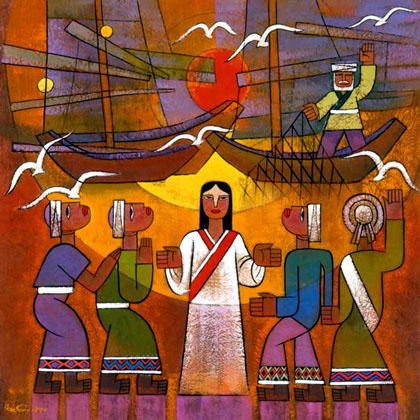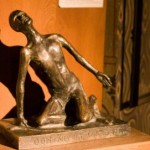 In a murderous time, the heart breaks and breaks and lives by breaking. – Stanley Kunitz, in The Testing Tree
In a murderous time, the heart breaks and breaks and lives by breaking. – Stanley Kunitz, in The Testing Tree
When John was arrested, Matthew writes, Jesus fled. He fled Jerusalem and the Jordan region, and even Nazareth, the town to which Joseph had brought him, his safe place since he was two. In Capernaum, out of sight for the moment, Jesus begins calling disciples, who willingly follow him. His purpose: adding their voices to the proclamation of the dangerous news that the reign of God is near.
In the life of the people, in synagogue and in churches, the ritual prayer has always been: Someday you will come to us, O Lord. Jesus goes from town to town proclaiming, Now. The ritual story has always been: You were with us, O God, and we sinned. You departed, and we are ashamed, waiting for you to forgive and heal our misery. Jesus preaches differently: Turn away from the old understanding – now is the time of God’s loving kindness, mercy, justice, new beginnings, and joy. He tells this good news in a murderous time.
 No one can hear Jesus as Polyannish, for all know that John has been arrested and the preacher before them is a wanted man. But there is an air of subversion in Jesus’ tale, for joy is to bullies what water was to the Wicked Witch of the West: melting. But the dissolution of wickedness does not erase heartbreak, nor prevent it from recurring. And it is to the telling of heartbreak, as well as to telling of joy, that the disciples are called as storytellers.
No one can hear Jesus as Polyannish, for all know that John has been arrested and the preacher before them is a wanted man. But there is an air of subversion in Jesus’ tale, for joy is to bullies what water was to the Wicked Witch of the West: melting. But the dissolution of wickedness does not erase heartbreak, nor prevent it from recurring. And it is to the telling of heartbreak, as well as to telling of joy, that the disciples are called as storytellers.
Jesus’ stories tell heartbreak as well as joy, and so will theirs. Martin Luther King Jr was a such a storyteller, whose voice told forbidden stories of heartbreak and joy. His voice rose above the murderous clamor which threatened to drown him out. Not forever, but for long enough that millions of Americans heard and followed, and in their listening they became his safe place for several precious years, before his inevitable assassination.
It is not to the telling of his one life only that Jesus has called disciples, but to the telling of how it is to be human in endless variation, and how God is with us in that. The film, Saving Mr. Banks, tells the story of two modern tellers of the human tale: P.L. Travers, the woman who wrote Mary Poppins, and Walt Disney, the man who made children’s stories into Polyannish films. If they seem unlikely disciples, they are no more unlikely than Andrew and Simon were.
 P.L. Travers is revealed as an irascible woman, a perfectionist for whom no one is good enough, a controlling and suspicious person. Walt Disney is revealed as every inch the consummate businessman hunting for a deal. She suspects him of conning her. He assumes she has a price. The story of their difficult working relationship, recorded on tape at the time, is both heartbreaking and comedic. (See Acts for details of how hard it was for the disciples to get along.) It was not until they shared the truth, which Walt Disney finally put on the table, that they were both haunted by memories of heartbreaking childhoods and betrayal by their fathers, that they could arrive at an Amen, and we could enjoy an iconic film of a treasured book.
P.L. Travers is revealed as an irascible woman, a perfectionist for whom no one is good enough, a controlling and suspicious person. Walt Disney is revealed as every inch the consummate businessman hunting for a deal. She suspects him of conning her. He assumes she has a price. The story of their difficult working relationship, recorded on tape at the time, is both heartbreaking and comedic. (See Acts for details of how hard it was for the disciples to get along.) It was not until they shared the truth, which Walt Disney finally put on the table, that they were both haunted by memories of heartbreaking childhoods and betrayal by their fathers, that they could arrive at an Amen, and we could enjoy an iconic film of a treasured book.
The telling of heartbreak may, in fact, always be dragged out of us, one tear at a time. In this case, it took great financial need, months of argument, and painful self-revelation, for them to be able to arrive at a true telling, instead of a farce or a lie. P.L. Travers’ drunken father, who seems to have been severely bi-polar, lived and died (when she was 6) in delusions fueled by alcohol, but loved his daughter deeply and encouraged her imaginative life. Disney’s driven father worked both his sons abusively under the rubric of thrift, yet was skilled at business and encouraged Walt’s success.
Travers suspected Disney would make Mary Poppins too sweet and mild, and Mr. Banks too mean. And she was right. Her objections were crucial to their work. Disney at last saw that Travers was afraid to let her father (Mr. Banks) live again. In confessing his own demonic memories to her, he won her consent to try. Neither Travers nor Disney was able to break free of the heartbreak of childhood. Yet both were able to express the love threaded through those painful childhoods in stories that feed the world.
It isn’t to the perfect telling of one story that Jesus calls disciples, it is to the truthful telling of every story. Truthful tales always have an equal measure of pain and joy. (Think of the Prodigal Son, the Good Samaritan, the wise and foolish virgins, etc.) The power to save appears in them in ordinary people, who, like Mary Poppins, are magical in teaching you to know your own powers and to use them for mercy and for freedom. At the end of true stories, you always know that love was at work the whole way through, even when everyone hurt. And that’s good news. ________________________________________________________
1. Calling Disciples by He Qi, 2001, China. Vanderbilt Divinity School Library, Art in the Christian Tradition.
2. Calling Saints Peter and Andrew, by Duccio di Buoninsegna, National Gallery of Art, Washington D.C. Vanderbilt Divinity School Library, Art in the Christian Tradition.
3. Mary Poppins movie Poster, 1964.











